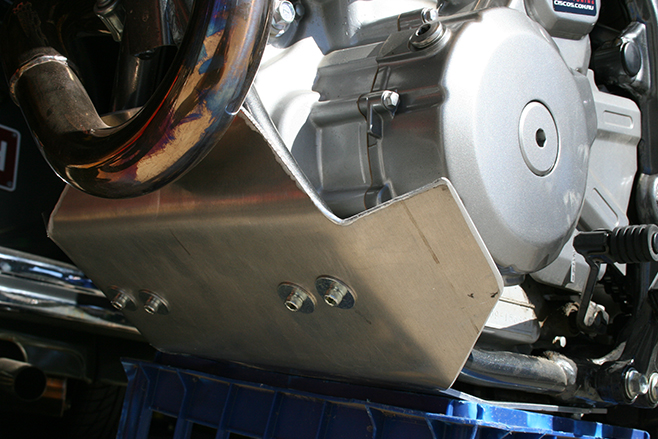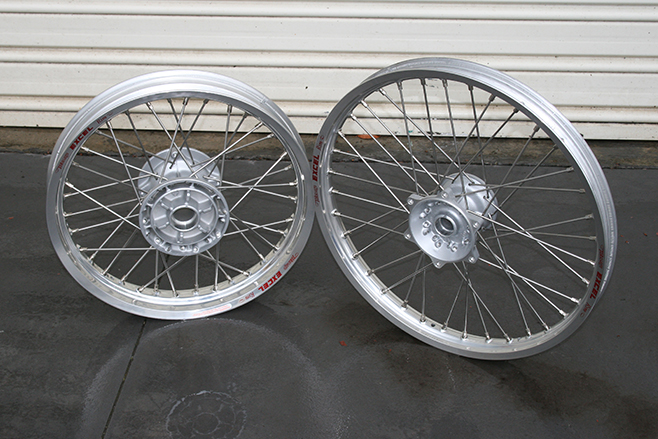10 must do adventure modifications.
When a few cents per bike makes a big difference to the manufacturer’s bottom line, you can bet that even the best motorbike can be improved upon. And if you’re going seriously bush, then making the machine work better and more reliably will improve the experience. And it might just save your bacon. Here’s a few mods we’d recommend.
-
- Get tanked.Ever wondered why an otherwise great adventure bike like a Suzuki DR650 has such a tiny tank? Us too, and it’s not just the DR that’s guilty of this huge oversight. A large capacity fuel tank not only gives you peace of mind, it can be absolutely essential in really remote places like Central Asia and South America. Aussie-made tanks are available and super-tough. A clear or opaque one lets you check the fuel level at a glance.
- Engine tune.Most people tune their bikes for the altitude they live at. This doesn’t necessarily apply to adventure bikes and if you’re going for the heights, then a tune up before you go is good thinking. As altitude increases, your engine will run richer, so the trick is to make sure it isn’t already running rich at sea level (where most of us live).
- Getting all your gear to fit on a bike is one thing, keeping it dry and not having it fall off the bike on day one is another. Obviously space is the main consideration, but think about keeping the weight low by using panniers and remember that soft panniers are vastly less likely to break your leg in a tumble. Also, have a day pack for valuables that is secure but easily removable whenever you leave the bike.
- Crash bars/sump guard. Crash bars speak for themselves and axle protectors have a role to play when it goes wrong.

A sump guard is equally obvious but find one with an access hole so that you can remove the sump plug without having to remove the guard first.
-
- Be seated.A motorbike is absolutely no use to you if you can’t bear to sit on it. And dirt bike seats are among the worst. Look at aftermarket replacements but don’t rule out having the original seat re-sculpted and re-padded with foam of different densities. It can be cheaper and just as effective.
- Rims. The first time you ride merrily into an unmarked crater in deepest Kazakhstan, you’ll congratulate yourself on having had stronger wheels made. Find a pair of spare hubs and then have an expert use thicker spokes to lace on a tougher, aftermarket rim.

Think about changing to spoked rims on bikes with alloy rims. Don’t fear the inner tube.
- A lot of standard bikes are over-geared in the interests of highway cruising and fuel economy. But for gnarly terrain, it’s better to gear down a little to make first gear a bit more of a grunt-fest. A couple or three extra teeth on the rear sprocket is often enough.
- Modern LED lights are your friend here. They offer a useful upgrade over the standard, El Dimmo light fitted to dirt bikes as standard and even if you don’t plan to ride at night, we bet you’ll get caught after dark at some stage. And because they draw very little current, you can use LED driving lights to pitch your tent in the dark without flattening the battery. Add a switch so the LEDs will work independent of the bike’s ignition. But hide it, because kids love flipping every switch on a parked bike.
- Bars/pegs.You and I both know that in sandy or other soft surfaces, you need to get your bum off the seat and get your weight towards the rear of the bike. If you can’t stand comfortably, that just won’t work. Make sure the bars are high enough and think about a lowering kit for the pegs if you’re taller.
- Going seriously off-road? Then road-legal nobbies are your friend. But if you’re planning on a mix of surfaces, then a trials-universal hoop might be the go. Just be wary of any tyre with a too-stiff sidewall. Yes, they’ll be more resistant to punctures, but some are so stiff, they physically cannot be changed using the short tyre levers you’re most likely to be carrying.
Dave Morley is a freelance motoring writer who loves adventures.












